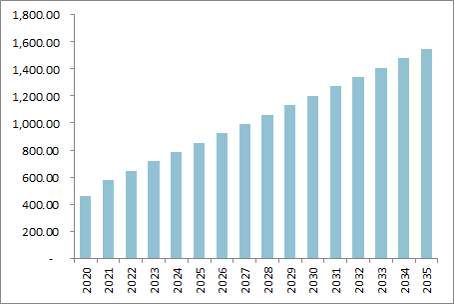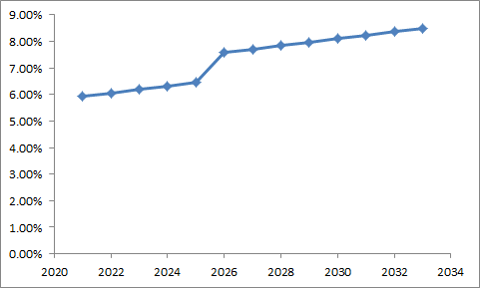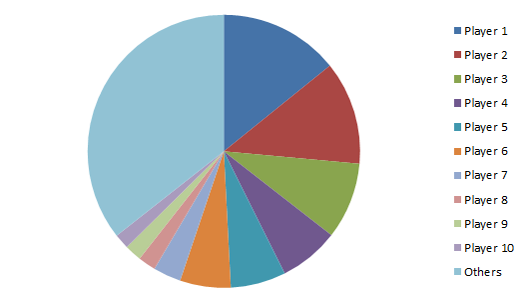Global Recirculating Aquaculture Systems (RAS) Farmed Salmon Market Comprehensive Study 2024
Global Recirculating Aquaculture Systems (RAS) Farmed Salmon Market: By Type (Atlantic Salmon, Sockey Salmon, Coho Salmon), By Application (Food Services, Retail, Others); and By Regions (Norway, Chile, U.K, Canada, Faeroe Islands, Australia, United States, Japan, Ireland, Rest of World) – Historical & Forecast Period (2020-2035) Comprehensive Study 2024
- Published Month : July 17, 2024
- No. of pages: 180
- Overview
- Table of Content
- Scope of Study
Recirculating Aquaculture Systems (RAS) Farmed Salmon Market Overview:
Global Recirculating Aquaculture Systems (RAS) Farmed Salmon market size was valued at USD 651.49 Million in 2023 and is expected to reach USD 23,200 Million at a (CAGR) of XX% from 2023 to 2035.
Sustainability and Environmental Concerns:
- Reduced Environmental Impact: RAS significantly reduces the environmental footprint of salmon farming by minimizing water usage and waste discharge compared to traditional open-net pen systems.
- Conservation of Wild Fish Stocks: RAS systems can reduce the need for wild-caught fish for feed, supporting sustainable fisheries and decreasing pressure on marine ecosystems.
Technological Advancements:
- Improved System Efficiency: Advances in filtration, water treatment, and monitoring technologies have enhanced the efficiency and effectiveness of RAS, making them more viable and cost-effective.
- Health Management: RAS systems allow for better control over environmental conditions, which can lead to healthier fish and reduced need for antibiotics and other treatments.
Demand for High-Quality Seafood:
- Consumer Preferences: There is growing consumer demand for fresh, high-quality, and responsibly farmed seafood. RAS can provide a consistent and high-quality product year-round.
- Food Safety: RAS systems offer enhanced control over the rearing environment, which can improve food safety and traceability, addressing concerns about contaminants and disease.
Regulatory and Market Pressures:
- Stricter Regulations: Governments and regulatory bodies are implementing stricter environmental regulations for aquaculture, driving the adoption of more sustainable practices like RAS.
- Market Access and Certifications: RAS farmed salmon often meet the criteria for various sustainability certifications, opening access to markets that prioritize eco-friendly products.
Economic Factors:
- Operational Efficiency: Although the initial investment in RAS technology can be high, it can result in lower operational costs in the long run due to reduced water and feed usage, and less waste management.
- Land Use: RAS systems can be set up in urban or non-traditional locations, reducing the need for large-scale land use and enabling proximity to major markets.
Climate Change Adaptation:
- Resilience to Environmental Changes: RAS systems are less affected by climate change impacts, such as temperature fluctuations and ocean acidification, making them a more resilient option for salmon farming.
Investment and Innovation:
- Increased Investment: Growing investment from both private and public sectors in RAS technology is driving innovation and scaling up of these systems.
- Research and Development: Ongoing R&D efforts are continually improving the efficiency, cost-effectiveness, and environmental performance of RAS systems.
Global Recirculating Aquaculture Systems (RAS) Farmed Salmon Market Revenue (USD Million), (2020-2035)

Global Recirculating Aquaculture Systems (RAS) Farmed Salmon Market YOY (%), (2020-2035)

Top Recirculating Aquaculture Systems (RAS) Farmed Salmon Market Players Share (%), 2024

Top Market Players:
- Leading companies in the Recirculating Aquaculture Systems (RAS) Farmed Salmon market include Samherji Fiskeldi HF, Danish Salmon A/S, Emirates AquaTech Ltd. and others
Study Coverage
| Metrics | Details |
| Years | 2020-2035 |
| Base Year | 2023 |
| Market Size | Revenue (USD Million) and Volume (K Tons) |
| Regions | Norway
Chile U.K Canada Faeroe Islands Australia United States Japan Ireland Rest of World |
| Segments | Type (Atlantic Salmon, Sockey Salmon, Coho Salmon)
Application (Food Services, Retail, Others) |
| Players | Samherji fiskeldi hf, Danish Salmon A/S, Emirates AquaTech Ltd., Atlantic Sapphire AS, Pure Salmon Holding Ltd., Superior Fresh LLC, West Creek Aquaculture LLC, Cape Nordic Corporation Ltd., Nordic Aquafarms Inc., Sustainable Blue Inc., Andfjord Salmon AS, Kuterra Limited, AquaBounty Technologies, Inc., and Others |
Recirculating Aquaculture Systems (RAS) Farmed Salmon Insights
- Recirculating Aquaculture Systems (RAS) Farmed Salmon Market Revenue Size (USD Million)/Volume Size
- Recirculating Aquaculture Systems (RAS) Farmed Salmon Market Players Analysis
- Top 10 Buyers Details
- Recirculating Aquaculture Systems (RAS) Farmed Salmon Market Historical & Estimated Years (2020-2035)
- Recirculating Aquaculture Systems (RAS) Farmed Salmon Market Regional/Segments Analysis
- Recirculating Aquaculture Systems (RAS) Farmed Salmon Market Import/Export/Production Data
- 5 Successful Primary Validated Sources
- Recirculating Aquaculture Systems (RAS) Farmed Salmon Market Customization Options
- Post-Sales Support
Global Recirculating Aquaculture Systems (RAS) Farmed Salmon Market: By Type (Atlantic Salmon, Sockey Salmon, Coho Salmon), By Application (Food Services, Retail, Others); and By Regions (Norway, Chile, U.K, Canada, Faeroe Islands, Australia, United States, Japan, Ireland, Rest of World) – Historical & Forecast Period (2020-2035) Comprehensive Study 2024
1. Global Recirculating Aquaculture Systems (RAS) Farmed Salmon Market Outlook
2. Global Recirculating Aquaculture Systems (RAS) Farmed Salmon Market Executive Summary
2.1. Global Market Revenue Size (USD Million) and (K Tons) (2020-2035)
2.2. Key Trends By Segments (2020-2035)
2.3. Key Trends By Geography (2020-2035)
3. Global Recirculating Aquaculture Systems (RAS) Farmed Salmon Market Key Vendors Analysis
3.1. Regulatory Framework
3.2. New Business and Ease of Doing Business Index
3.3. Case Studies of Successful Key Ventures
3.4. Top Players Comparative Analysis
3.4.1. Country/Regions
3.4.2. Type
3.4.3. Applications
3.5. Key Vendors
3.5.1. Top 5 Vendors Pricing Analysis
3.5.2. Product Benchmarking
3.5.3. Future Investment Plans
3.6. Recirculating Aquaculture Systems (RAS) Farmed Salmon Market – Forces
3.6.1. Drivers
3.6.2. Restraints
3.6.3. Challenges
3.6.3.1. Porter’s Five Forces Analysis
3.6.3.1.1. Bargaining Power of Suppliers
3.6.3.1.2. Bargaining Power of Buyers
3.6.3.1.3. Threat of New Entrants
3.6.3.1.4. Threat of Substitutes
3.6.3.1.5. Degree of Competition
4. Global Recirculating Aquaculture Systems (RAS) Farmed Salmon Market Revenue (USD Million) and Volume (K Tons) Size (2020-2035)- By Geographical Analysis
4.1. Norway
4.2. Chile
4.3. U.K
4.4. Canada
4.5. Faeroe Islands
4.6. Australia
4.7. United States
4.8. Japan
4.9. Ireland
4.10. Rest of World
5. Global Recirculating Aquaculture Systems (RAS) Farmed Salmon Market Revenue (USD Million) and Volume (K Tons) Size (2020-2035)- By Type
5.1. Atlantic Salmon
5.2. Sockey Salmon
5.3. Coho Salmon
6. Global Recirculating Aquaculture Systems (RAS) Farmed Salmon Market Revenue (USD Million) and Volume (K Tons) Size (2020-2035)- By Applications
6.1. Food Services
6.2. Retail
6.3. Others
7. Company Profile Analysis
7.1. Danish Salmon A/S
7.1.1. Vendors Overview
7.1.2. Business Portfolio
7.1.3. Geographical Portfolio
7.1.4. Customers
7.1.5. Financial Analysis
7.1.6. Recent Developments
7.2. Samherji fiskeldi hf
7.3. Emirates AquaTech Ltd.
7.4. Atlantic Sapphire AS
7.5. Pure Salmon Holding Ltd.
7.6. Superior Fresh LLC
7.7. West Creek Aquaculture LLC
7.8. Cape Nordic Corporation Ltd.
7.9. Nordic Aquafarms Inc.
7.10. Sustainable Blue Inc.
7.11. Andfjord Salmon AS
7.12. Kuterra Limited
7.13. AquaBounty Technologies, Inc.
7.14. Others
8. Sources Covered
8.1. Primary Sources
8.2. Secondary Sources
- By Type (Atlantic Salmon, Sockey Salmon, Coho Salmon)
- By Application (Food Services, Retail, Others)
- By Regions (Norway, Chile, U.K, Canada, Faeroe Islands, Australia, United States, Japan, Ireland, Rest of World)













